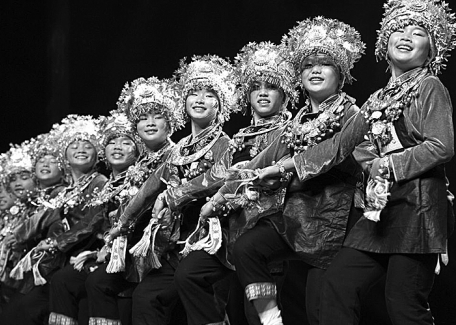
CHINA DAILY
Dancers of the Miao ethnic group from Dayu village, Guizhou province, perform Stomp Down the Moon during the Lotus Award dance competition.
Yes, they still warp their bodies to unbelievable shapes, gyrate for a full minute without losing balance, lift up their partners and spin them overhead. But when it comes to folk-dance competitions, there is something else to watch for.
There are folklores, legends and traditions of various ethnicities that lie beyond the dances.
For the entries of the prestigious Lotus Award, the country's highest honor in folk dancing, it's especially true.
Yang Zaiqing, a Miao ethnic native from Dayu village, Guizhou province, has brought a unique ritual dance, Stomp Down the Moon to the Lotus Award stage in Guiyang, Guizhou province, in mid-November.
Neat rows of primary and middle school students from his tribe of Bailing, Miao ethnic group, vigorously thump the floor. It's similar to a heavy tap dance, except they raise their legs high and land full on the sole with very loud "clicks" of the shoes.
"It's so refreshing and full of life," comments Zhao Linping, veteran dancer and researcher of ethnic dances at Inner Mongolian University.
Indeed, the dance, which is an everyday ritual for the group, is designed to revive the moon.
"For us, the moon is the supreme being and we worship her," Yang, who also played a jumpy tune on the lusheng, a Chinese musical instrument with multiple bamboo pipes.
"This dates back to hundreds of years ago when we fled and migrated from Jiangxi province and had to live in the wild," Yang, the Chinese teacher at the Sandu Dayu school says. "The moon guided us and fed us. The name of our clan, Gailai, means 'live again'. And we still do the stomping dance in front of rice paddies and wish for harvests today."
"Everybody, men and women, young and old, celebrates the moon."
The group depends on lusheng, the reed-pipe instrument in much the same way. "A lusheng sounds, our soles itch. We are wired like this," Yang says.
Yang says every element of the dance comes straight from their customs that still live today. And moon-stomping won a silver prize.
"It's among the presentations of customs that are most affecting, it has rhythms and emotions," says Feng Shuangbai, vice-president of the China Dancers Association.
Even funeral rituals make their way onto the stage. Hailing from eastern Yunnan province where the Yi ethnic group resides, the city Qujing presented a "Que'o'quebi" dance.
That translates to "singing and dancing really loudly".
"The Yi's have a different philosophy. For them, passing away from this life is never sad and traumatic," says Yang Wenlong, the choreographer who discovered the tradition.
"They say the departed are going to their Xanadu and beginning a new life. For them, life doesn't stop at physical death. It goes on and they celebrate the next phase. That's why people there are calmer and much less anxious about their life."
Dancers take to the stage wearing bright red. They hold a drum and jauntily bounce around. In real life, the Yi ethnic group members carry and pat basins and wear white towels to fend off flies.
"They would place the coffin onto a very tall tree, then chant and dance around it for three days," Yang says.
Without being put into context, the dance, accompanied by a mysterious language, is just an average group dance.
"We want their view of death to be known and respected," Yang says.
Indeed, it's almost impossible to grasp the full beauty of these folk dances until you've done enough homework.
The gold-winning dance The Mountain Sun draws on the ethnic group's legend with the sun-its defiant ancestors have shot the sun down.
The Mongolian dance Gobi Desert, another gold-winner tells of their life in the arid climate-water is short so when they see an oasis they dance in jubilation.
"Ethnic dances are special because they have to remain true to their traditions, they have to be down-to-earth and show ethnic life as it really is," says Bao Xiangxin, judge and vice-president at the China Promoting Ethnic Culture and Art Association.
"When we talk about planting one's root to the native ground, this is what we mean," says Ma Wenjing, a national choreographer with the Committee of the Academy of Ethnic Folk Dances.
"You are grounded when you take the traditions to heart, with love and passion. Don't invent but look deeper into the repertoire of folklores, it's inexhaustible treasure," Ma says.
We recommend:
